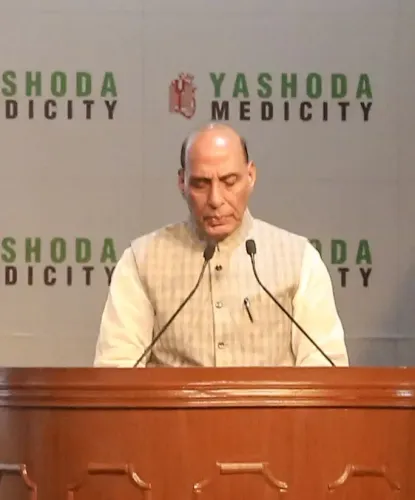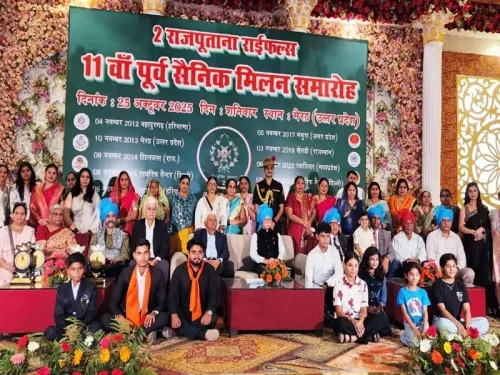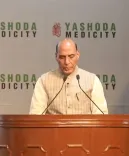What Impact Did Cyclone Montha Have on MP?

Synopsis
Key Takeaways
- Unseasonal rains have caused disruptions in Madhya Pradesh.
- The IMD has issued alerts for potential flooding.
- Cyclone Montha is anticipated to develop in the coming days.
- Residents are advised to take precautions against flooding.
- Implications for agriculture and daily life are significant.
Bhopal, Oct 26 (NationPress) Unseasonal rainfall caused significant disruptions to daily activities throughout Madhya Pradesh on Sunday, with numerous districts experiencing heavy downpours, leading to alerts for potential flooding and other disruptions.
The Bhopal center of the India Meteorological Department (IMD) reported varied precipitation across the state in the past 24 hours, driven by a deep depression in the southeast Bay of Bengal and another in the east-central Arabian Sea, which could develop into the cyclonic storm named 'Montha'.
Isolated rainfall was noted in areas such as Ujjain, Gwalior, Chambal, and Sagar divisions; several locations in Jabalpur; many in Indore; and the majority in Bhopal and Narmadapuram. The rest of the state remained predominantly dry.
Bhainsdehi saw the highest rainfall at 71 mm, followed by Pati with 42 mm, Bhimpur at 41 mm, Chicholi at 38 mm, and Khargone at 35.8 mm. Gusty winds reached 35 kmph in Agar Malwa, 33 kmph in Shajapur and Sagar, 31 kmph in Sehore, and 30 kmph in Ujjain.
Thunderstorms accompanied by lightning affected Indore (excluding Neemuch and Ratlam), Ujjain, Bhopal, Narmadapuram, and Jabalpur (excluding Dindori), as well as districts like Sheopur Kalan, Ashoknagar, Sagar, Damoh, and Tikamgarh. Betul experienced substantial rainfall.
Temperatures saw a significant drop, with maximums falling by 4.9 degrees Celsius in Narmadapuram, and by 2.2-3.0 degrees Celsius in Indore, Jabalpur, and Shahdol. These temperatures were notably below normal (3.7-4.5 degrees Celsius) in Indore and Narmadapuram, and below normal (1.6-2.4 degrees Celsius) in areas like Bhopal and Gwalior.
Minimum temperatures did not show significant changes but remained above normal in various divisions, with Shahdol notably higher by 8.3 degrees Celsius.
Lowest minimums were reported in Khandwa (16.4 degrees Celsius) and Sheopur (17.0 degrees Celsius); the highest were in Satna (23.6 degrees Celsius). The lowest maximum was in Pachmarhi (24.2 degrees Celsius) and the highest in Khajuraho (32.8 degrees Celsius).
Current synoptic features indicate the Bay of Bengal’s deep depression is moving west-northwest at 6 kmph and is likely to intensify into a cyclonic storm in 24 hours, with a possibility of becoming severe by October 28, crossing the coast of Andhra Pradesh.
The Arabian Sea depression is moving southwest at 13 kmph. A trough persists from this area to western Madhya Pradesh.
Rainfall and thunderstorms are anticipated on Monday in isolated locations across 31 districts, including Bhopal and Jabalpur; some in six districts like Raisen and Indore; and many in 15 districts such as Narmadapuram and Betul. Gusty winds (30-40 kmph) and thunderstorms are expected in isolated areas of Mandsaur and Neemuch; broader alerts are in effect for 24 districts.
The Bhopal center of IMD has issued warnings regarding potential waterlogging, localized flooding, traffic disruptions, power outages, and lightning hazards.
Residents are advised to steer clear of flooded areas, disconnect electrical devices, and safeguard crops amid high humidity. Farmers are encouraged to utilize light traps for pests and prepare their rabi fields.
Cloudy conditions accompanied by rain and haze are expected to persist in Bhopal city with winds of 8-10 kmph on Monday. This atypical weather for the post-monsoon season could have implications for agriculture and travel.








